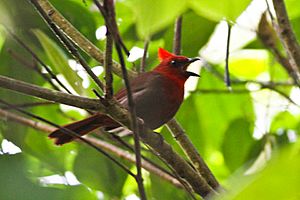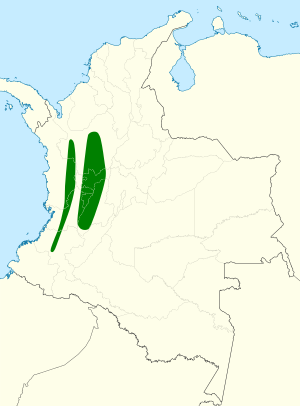Crested ant tanager facts for kids
Quick facts for kids Crested ant tanager |
|
|---|---|
 |
|
| Conservation status | |
| Scientific classification | |
| Genus: |
Habia (bird)
|
| Species: |
cristata
|
 |
|
The crested ant tanager (Habia cristata) is a colorful bird that belongs to the Cardinalidae family. This means it's related to cardinals and grosbeaks. You can only find this bird in Colombia, which makes it endemic to that country.
Contents
What is a Crested Ant Tanager?
Its Scientific Name and Family
Scientists first thought the crested ant tanager was part of the Thraupidae family, which includes "true" tanagers. But in the early 2000s, new studies looked at the birds' DNA. This research showed that all birds in the Habia group, including the crested ant tanager, are actually more closely related to cardinals. So, they were moved to the Cardinalidae family.
The crested ant tanager is a monotypic species. This means it doesn't have any different subspecies or types within its group. It's just one unique kind of bird!
What Does it Look Like?
The crested ant tanager is about 19 centimeters (7.5 inches) long. That's about the length of a standard pencil!
Male and Female Birds
The male bird is quite striking. Its head is a dark red color, and it has a bright scarlet (very red) crest on top. This crest is like a fancy hairdo! The rest of its upper body changes from red on its shoulders to a brownish-red near its tail. Its throat and chest are a vibrant red, while the rest of its belly is gray, sometimes with a hint of red.
The female crested ant tanager looks similar to the male, but her colors are not as bright. Her crest is also smaller. Young birds don't have a crest at all. They are reddish-brown on their backs and a cinnamon color underneath.
Where Does it Live?
The crested ant tanager lives only in Colombia, a country in South America. You can find it on both sides of Colombia's Western Andes mountains, from the Antioquia Department down to the Cauca Department. It also lives on both sides of the Central Andes, from Antioquia to the Tolima Department.
Its Home in the Forest
This bird prefers to live in the lower parts of humid forests, both in mid-level and mountain forests. It especially likes places with thick plants, like along streams, near natural openings (like where a landslide has cleared trees), and in deep valleys called ravines. Sometimes, you might spot it in more open areas too. These birds live at elevations from about 700 meters (2,300 feet) up to 2,000 meters (6,560 feet) above sea level.
How Does it Behave?
What it Eats
The crested ant tanager mostly eats insects and other arthropods, which are like bugs with exoskeletons. But it also enjoys eating seeds from palm trees and other fruits. These birds usually search for food in pairs or small groups among the plants close to the ground. Sometimes, they even fly out quickly to catch insects in the air. Interestingly, groups of these birds have been seen following army ant swarms. These ants stir up other insects, making them easy prey for the birds!
How it Raises its Young
Scientists haven't found much information about how these birds raise their young. However, one crested ant tanager was seen carrying materials to build a nest in a ravine during June. It was with two other birds. This is the only published observation about their breeding habits so far.
Its Calls and Songs
The crested ant tanager has a special song it sings at dawn, which sounds like repeated "che'ik" notes [1]. When it feels threatened or wants to warn others, it makes a "loud, shrill 'Chi-veek!'" sound [2].
Is it in Danger?
The IUCN (International Union for Conservation of Nature) has looked at the crested ant tanager's situation. They have listed it as a species of "Least Concern." This means it's not currently in immediate danger of disappearing.
However, even though it's "Least Concern," its numbers are likely going down. This is because of deforestation, which is when forests are cut down. This loss of habitat means the bird's living areas are shrinking and becoming separated. Experts believe that the crested ant tanager might be at risk in the near future if deforestation continues.
See also
 In Spanish: Piranga hormiguera copetona para niños
In Spanish: Piranga hormiguera copetona para niños


